Baptism

I was asked to contribute a chapter to a new book called Disquiet Time: Rants and Reflections on the Good Book by the Skeptical, the Faithful, and a Few Scoundrels. The volume, an edited compilation put together by Cathleen Falsani and Jennifer Grant, takes on many of the weird texts in scripture that we either gloss over or completely ignore because they’re just too … well, weird.
Of course there are plenty of spiritual oddballs to choose from, but as soon as I got the invite, I knew I wanted to write about the book of Revelation (note that there is not “S” at the end; there is no such book as Revelationsssssssss in the Bible). Suffice it to say that my relationship with the last book in the bible is a little bit complicated. In fact, it ruined my potential career as a lifetime Baptist. A number of you may have heard bits or pieces of the story about how I got kicked out of church as a teenager, but may not know all the details.
Well kids, you can blame it all on one freaky Bible book, one intransigent teenager and a floppy-Bible-wielding youth minister. But although the experience pushed me out of church for a solid decade, it didn’t forever ruin my search for the divine. But this particular story isn’t about that. It’s about how I got one particular youth minister so red-faced and flustered that he cussed me out and almost hit me square in the noggin with the Good Book.

While Christians waited to learn whether the Church of England would approve the consecration of women bishops, the church’s governing body — the General Synod — quietly voted to drop all future references to the devil in a new baptism service.
In the traditional service, godparents are asked whether they are ready to renounce the devil and all his works for the sake of the child being baptized.
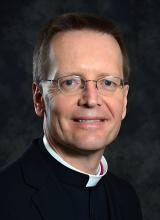
Despite numerous controversies over dismissing gay Catholics from church posts and the U.S. hierarchy’s campaign against same-sex marriage, Catholic leaders have carefully, if quietly, avoided doing anything to block gay couples from having their children baptized.
But a move by a bishop in Wisconsin to route all such decisions through his office is raising questions about whether that neutral zone will now become another battleground, and whether the growing acceptance of gay parents will inevitably draw more attention to this practice and force church leaders to establish clearer rules.
The default position for most bishops — reiterated in a major Vatican document released on Thursday — is that if the parents pledge to raise the child Catholic, then no girl or boy should be refused baptism.
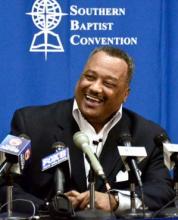
For Southern Baptists, it’s happened again: Another annual report shows the denomination is losing members and baptizing fewer people.
The Rev. Fred Luter, outgoing president of the Southern Baptist Convention, thinks old-time methods to spread the gospel have met a culture that’s younger, more diverse, and doesn’t necessarily see the pew — or even sin — as a priority.
“Our society is just not what it used to be,” said Luter, who admitted he’s discouraged by the reports. “When I grew up there was a challenge by parents in the home that our sons and daughters would be in church. It was a given. … That day and time is gone.”
Luter said he and others will address the issue at this year’s annual meeting, which takes place June 10-11 in Baltimore. But beyond calls for reversing the trend, there’s little sign of agreement on a way forward.

Most people in their right minds consider Sarah Palin’s statement about using waterboarding to “baptize” terrorists as insensitive at the very least. It further reinforces the notion that she will say or do nearly anything to grab a headline, even if it is at the expense of her own integrity, and perhaps that of her political cohorts or even her faith.
She’d be doing all of us a favor if she’d simply stop talking publically. But in as much as she continues to be afforded a microphone and speaking pulpit, we get to bear witness to her attempts to improvise a caricature of herself on the fly.
Perhaps the most disturbing part of the statement to me is not the brazenness of it, or even the apparent lack of self-awareness or personal filter. It’s that she’s actually speaking on behalf of a significant – albeit shrinking – subset of Christian culture in the United States. It’s the strain that believes that the Prayer of Jabez (a prayer about expanding one’s spiritual territory) is a Manifest Destiny of sorts from Jesus to his followers. We’re to reach to all corners of the earth, emboldened with a “be assimilated or be eliminated” mentality at our backs.

Oh, Sarah Palin.
So you’ve most likely heard Sarah Palin used baptism as a metaphor for waterboarding terrorists. (I mean I heard and I’m in Australia!) I found out when fellow neo-Anabaptist Tyler Tully sent me his reflections. Many are blogging thoughtful responses. But more and more this is my conviction: the best critique of the bad is the practice of the beautiful. So I want to testify to the beauty of the baptisms I was a part of on Sunday.
I do so knowing that the despondence and darkness I feel when baptism is equated with the diabolical is driven out in the joy of the mystery of what happen when we say yes to the Holy Spirit by wading in the water. Our new sister Natha, brother Ky, and I met separately in the End Poverty movement. Both of them, in quiet different ways, found themselves being found by God while looking for a better world. And in Jesus they found the world they were looking for has started! Without a dry eye in the community that surrounded them on Sunday, they shared their wanderings in the wilderness before following Jesus through the waters.

“Jesus was led by the Spirit into the wilderness to be tempted by the devil.”
Thus begins the spiritual drama of Lent, the forty days before Easter that commemorates Jesus’ wilderness experience. No human, not even Jesus, can escape the temptation of the devil.
Just before Jesus was led into the wilderness, he was baptized in the Jordan River by John. As the Gospel of Matthew reports, when Jesus emerged from the water “a voice from heaven said, ‘This is my Son, my Beloved, with whom I am well pleased.’”
Jesus’ identity as God’s Son had always been true, but he received confirmation of his relationship with God at his baptism.
LUKE'S SECOND VOLUME, the Acts of the Apostles, tells the story of what happened to Jesus’ followers after they received spiritual power to be his witnesses “in Jerusalem, in all Judea and Samaria, and to the ends of the earth” (Acts 1:8).
Beginning in Jerusalem, the movement proceeds north and west, eventually tracing Paul’s journey to Rome. But the plot takes one big detour along the way, heading south to the mysterious lands beyond Egypt, carried by a person more foreign and unusual than any other in Luke’s vast cast of characters. Only divine intervention orchestrates the encounter between the Jewish Hellenist Philip and the Ethiopian eunuch in Acts 8:26-40.
What is the main thrust of this missionary story? Is it geography—a foray into “the ends of the earth” long before Paul reaches Rome? Is it religious ethnicity—the first God-fearing Gentile believer converting, even before the Roman centurion Cornelius? Is it the man’s undeniable African origins—straight from the lands of Nubia and Cush? Is it his wealth and connections to royalty that will enable him to bring Jesus’ gospel to Africa?
Luke likely included this story for all these reasons, but the text itself points over and over to what must be the driving force of Luke’s inclusive theology in this account—the rider in the chariot is not referred to by Luke as a man. Luke calls him a “court official” and a eunuch (8:27), and later calls him a eunuch four more times, but never a “man.” He has been castrated before puberty and trained to take sensitive positions not entrusted to males. He is beardless with a higher voice. Torn from his birth family and enslaved at a young age, he has no family of his own. Loyal only to his queen, he is “in charge of her entire treasury.”

One sort of Christian believes taking Eucharist weekly saves her. Another Christian believes his confession of Jesus Christ as Lord saves him. Still another looks to his Baptism. Another to her participation in the body of Christ. One to his repentance. And another to her care for the sick, the hungry, the prisoner, and the poor.
We elevate one belief or practice over another, then divide ourselves as Christ followers by the priority we set when, in fact, all of these are taught as saving by Christ, who alone is our salvation.
Christ saves me, not the accuracy and purity of my beliefs. Christ saves me, not my works. Christ saves me, not the measure of my adherence to a doctrine or practice.
When all is said and done, many Christians tend to look to their habits, their faith, and their perseverance when it comes to salvation rather than to the work, belief, and faithfulness of Christ in us, over us, under us, and through us.
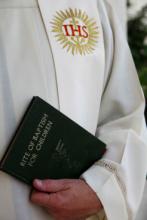
The Church of England has been accused of “dumbing down” the baptism service following the introduction of an alternative liturgy in which parents and godparents need not repent of their “sins” or reject “the devil.”
In the traditional version of the service, parents and godparents are asked: “Do you reject the devil and all rebellion against God?” and “Do you repent of the sins that separate us from God and neighbor?”
In the alternative version, now being tested in 400 churches, parents are instead asked to “reject evil and all its many forms and all its empty promises.”
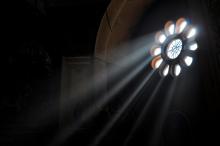
A NEW CALENDAR YEAR marks the end of the Christmas season and a shift to the season of Epiphany that spotlights the reality of the Incarnation. In sync with our personal promises to discontinue bad habits in favor of better practices, the lectionary readings capture familiar expressions of vocational clarity and ministerial frustration. The season is a mosaic of self-examination peppered with moments of great light penetrating the darkest despair. Whether ancient Israel (living in exile in the sixth century B.C.E.), the followers of Jesus (in the first century C.E.), or 21st century seekers of spirituality without religion, the description is the same: The disenfranchised, disappointed, and divided discover a glimpse of the reign of God.
Read these texts as snippets of ancient social media: status updates of a prophet, blogs about the ministry of Jesus, and PDF files about early church practices. Each exposes the light of God pushing into the darkness of human existence: frustrated ministers, radical promises of forgiveness, reports of flourishing charismatic leaders, stalemated efforts due to divided affiliations, petitions for lawmakers to practice impartiality, and the death of one imprisoned on suspicious testimony. Familiar, jarring, and too often tamed, these texts deserve at least the attention afforded public policy debates and celebrity rumors.
A close reading of the text does not lend safety by avoiding the prophet, ignoring John’s message, or disputing baptism rituals. Every baptized believer is called to arise and live as if the kingdom of God has come.

The rite of baptism got big press as Archbishop of Canterbury Justin Welby christened Prince George, a future king of England on Wednesday.
Welby made it a teachable moment for a country where only one in six are baptized. In a YouTube video, he explains that by bringing their son forward for baptism, Prince William and Duchess Catherine are “bringing God into the middle of it all.”
Last month, Pope Francis gave the sacrament a boost when he called a pregnant, unmarried woman to encourage her faith and offered to baptize her baby. While his main message was anti-abortion, his call also reminded Catholics that children of unmarried parents are welcome in the church.

At an interfaith summer camp in northern New Jersey, two dozen children explored a swamp to learn how creatures depend on safe water.
In Southern California, a Unitarian Universalist congregation installed a dry well so water from its church rooftops drains into underground pipes to replenish the water table.
In Vermont, members of a Lutheran church removed cars and appliances that had been dumped in a nearby stream and restored its banks with local willows and oaks.
Across the country, water has become more than a ritual element used in Christian baptismal rites or in Jewish and Muslim cleansing ceremonies. It has become a focus for worshippers seeking to go beyond water’s ritual symbolism and think more deeply about their relationship to this life-giving resource.

"HOW DID THIS HAPPEN?" pondered the middle-aged woman as she panted up the road to her village of Sychar, water jar forgotten. “How did we get into this heavy theological conversation from a simple request for a drink of water? Sometimes conversations take sharp turns, but this is just too bizarre. I’ve known a number of men in my life, but only the crazy ones told me they were the messiah! Better check this out with the town elders.”
In contrast to the approximately 800 references to water in the Hebrew Bible, the New Testament is relatively spare. A friend explained the difference. The ancient Hebrews emerged from the eastern desert cultures of Egypt and Babylonia (now Iraq), which built their empires around rivers and where water was scarce and precious. But the New Testament writers were oriented toward the wetter West, where seafaring Greeks and Romans had appropriated the Mediterranean Sea as their major mode of transportation and conquest. For example, even though the book of Acts only mentions the word “water” in reference to baptism, the early missionary movement depended on travel by ship to spread the gospel message.
Water in the synoptic gospels
All four gospels introduce us to John the Baptist down by the Jordan River, who dunks in its flowing water those who repent from sin as a symbol of their cleansing. After John moves offstage, the synoptic gospels center much of Jesus’ activity in the towns around the Sea of Galilee. Here he not only teaches from a boat (Matthew 13:2; Luke 5:3), but he and his disciples travel in it from one side of the lake to the other, which includes a miraculous walk on and rebuking of the stormy waves (Matthew 14:22-27; Mark 6:47-52; Luke 8:22-25). Other references to water are few and sometimes incidental.
THE ANACOSTIA RIVER is a river of contrasts. Often called “the nation’s forgotten river,” it flows for eight-and-a-half miles through some of the richest and poorest communities in and around D.C., through residential and industrial zones, through marshes and military installations. In fact, the federal government owns so much land in the watershed that when all those federal toilets flush during a heavy rain, they drain directly into the river.
The Anacostia River watershed is home to more than 800,000 people, 43 species of fish, and nearly 200 species of birds—including our nation’s symbol, the bald eagle, and the majestic great blue heron. Yet the trash in the river is so deep and wide at times that you’re just as likely to see a heron walking across a flotilla of trash rather than flying over the water.
As the Anacostia Riverkeeper—part of the Waterkeeper Alliance movement to protect local waterways—it was my job for three years to be the eyes, ears, and voice of its watershed. Of the nearly 200 waterkeepers worldwide, I was the only riverkeeper who was also a minister. I was called “Rev. Riverkeeper.”
The antiquated sewer system that pumps more than 2 billion gallons of raw sewage, mixed with polluted runoff, into the river each year is not just a shame, it’s a sin. African-American churches along the Anacostia used to baptize their members in the river. Nowadays, the river wouldn’t wash away anyone’s sins. My goal as Rev. Riverkeeper was an Anacostia that was not only “fishable” and “swimmable”—as required by the Clean Water Act—but also “baptizable.”

I GREW UP in rural Mississippi, a black girl who lived “out in the booneys,” fairly isolated from peers outside school. My God-fearing parents brought me up in an African Methodist Episcopal church that stood just beyond the edge of the woods. At the right age, I waded into a muddy watering hole, only recently vacated by the cows who drank there, and got dunked by the preacher and welcomed into the church and the kingdom of God.
That was my baptism, but I wouldn’t call it a conversion experience. I felt very innocent then, and would until I left home for college in Massachusetts. There I got my first taste of diversity. Most of my classmates didn’t believe as I did. Most of my African-American friends felt as if my faith was some kind of relic from our slave heritage, a white-supremacist trick that I had bought into.
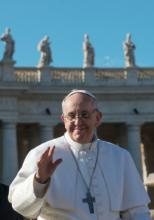
VATICAN CITY — Of all the novelties that Pope Francis has brought to the Vatican, few have endeared him to the public — and unsettled his aides — as much as his penchant for picking up the phone and calling someone out of the blue.
The pontiff with the pastor’s touch has phoned his cobbler in Argentina to inquire about a shoe repair, called to cancel his newspaper subscription, and phoned a woman who was raped by a local police officer to counsel her.
Just this week, Francis phoned a pregnant Italian woman whose fiancé had pushed her to have an abortion.
Anna Romano instead dumped the guy, wrote to the pope about her problems, and on Sept. 3 received a surprise call from the Holy Father, who offered encouragement and even said he would baptize the baby if she couldn’t find a willing priest.

AFTER SEVEN YEARS of theological, historical, and pastoral conversation, leaders of Reformed and Catholic churches in the U.S. this January signed a carefully worded, one-page agreement to mutually recognize the sacrament of baptism as it is practiced in each other's churches. This agreement represents dedicated—and inspiring—ecumenical work.
The agreement was signed by representatives of the Christian Reformed Church in North America, the Presbyterian Church (USA), the Reformed Church in America, the Roman Catholic Church, and the United Church of Christ. This agreement is not unprecedented, coming as it does nearly five decades since Vatican II's decree on ecumenism, in which the Catholic Church recognized non-Catholic baptism whenever "duly administered as Our Lord instituted it, and ... received with the right dispositions." However, for each tradition, baptism gives sacramental expression to that tradition's understanding of the church and what it means to be a member. For these churches to recognize each other's baptismal rites gives visible witness to their mutual desire for unity among the members of Christ's body.
This desire for unity between the churches is not an add-on to the gospel; it is not something we do if we happen to get to it. It is central to the saving work and mission of Jesus.
This January's agreement is spare in its requirements. It states that the use of water and a reference to the Trinity (Father, Son, and Holy Spirit) are all that are needed for mutual recognition. By specifying these two simple elements, the ecumenical team made a decision to respect the liturgical tradition of each church. The unique way that components of the rite have developed in each church—how catechesis is done, the use of scripture, the use of sponsors, anointing, and other elements—do not need to be changed.

In the church of my childhood it was taught that the “age of accountability” was somewhere around 12. To hit the age of accountability was to, like, spiritually go off of your parents’ insurance. At age 12 the clock starts ticking, spiritually speaking; you know right from wrong now and because of this you are accountable for every time you screw up. And if you sin knowing right from wrong and then die before you chose to be baptized, you might burn in Hell for eternity. So age 12, as you can imagine, is when kids start choosing to get baptized. The lag time between entering the age of accountability and having your slate wiped clean through baptism can be terrifying. Many of us kids would pray not to die in a car crash before we were baptized, like other people pray to not get sick before their employee benefits kick in. So basically, 12-year-old Church of Christ kids experience a wave of devotion like a Great Awakening comprised only of sixth graders. And this is partly because we were all terrified of the devil and temptation and sin. Since, as we were told, all the bad things we’d done may have been washed clean in baptism, but the devil was waiting right outside the baptistery to try and get us to be bad again.